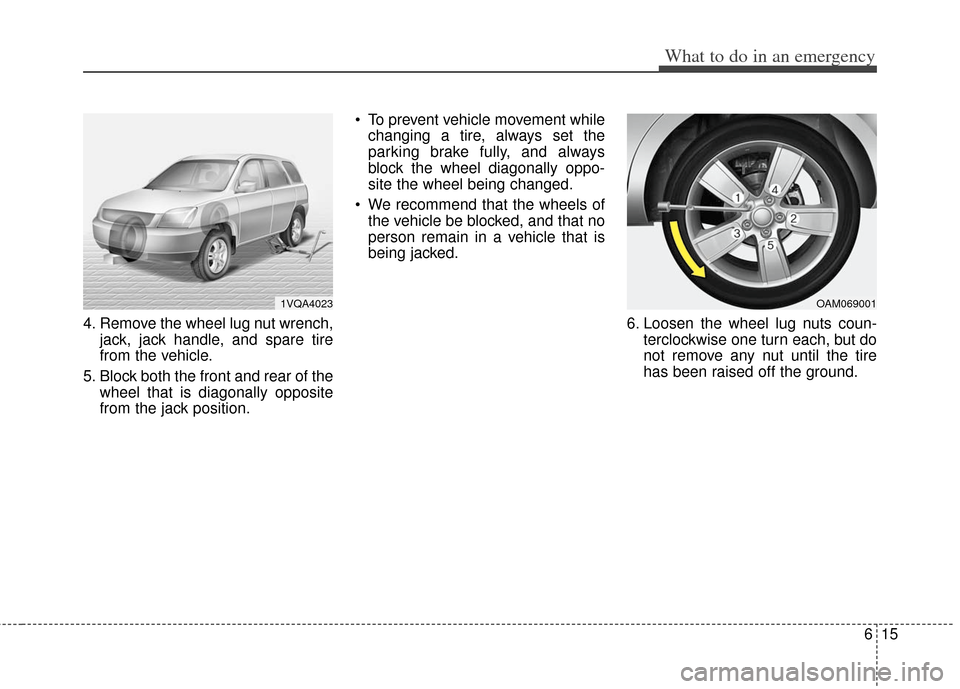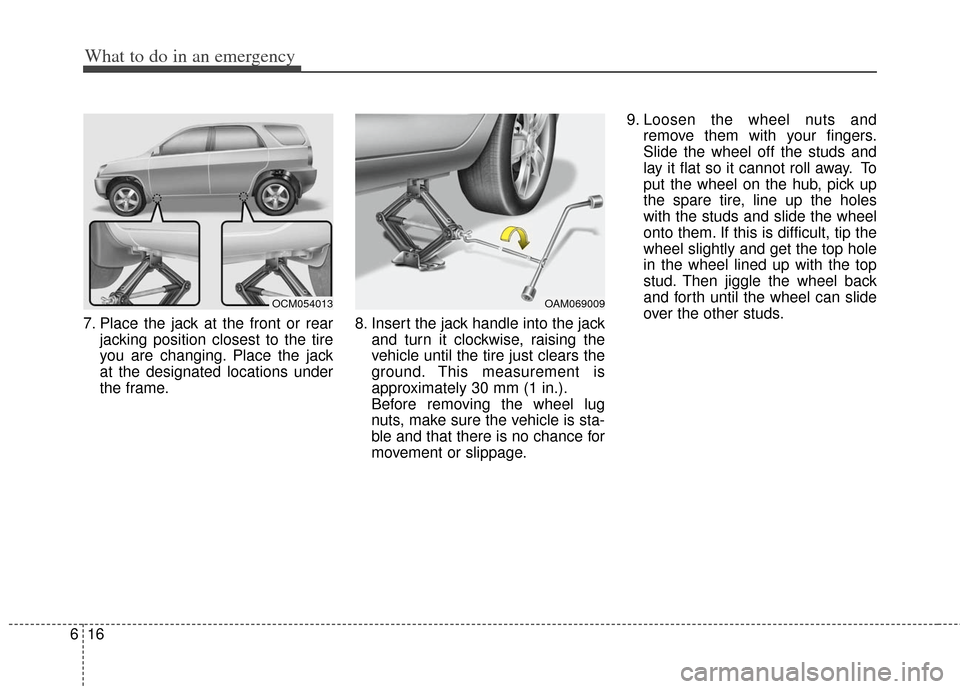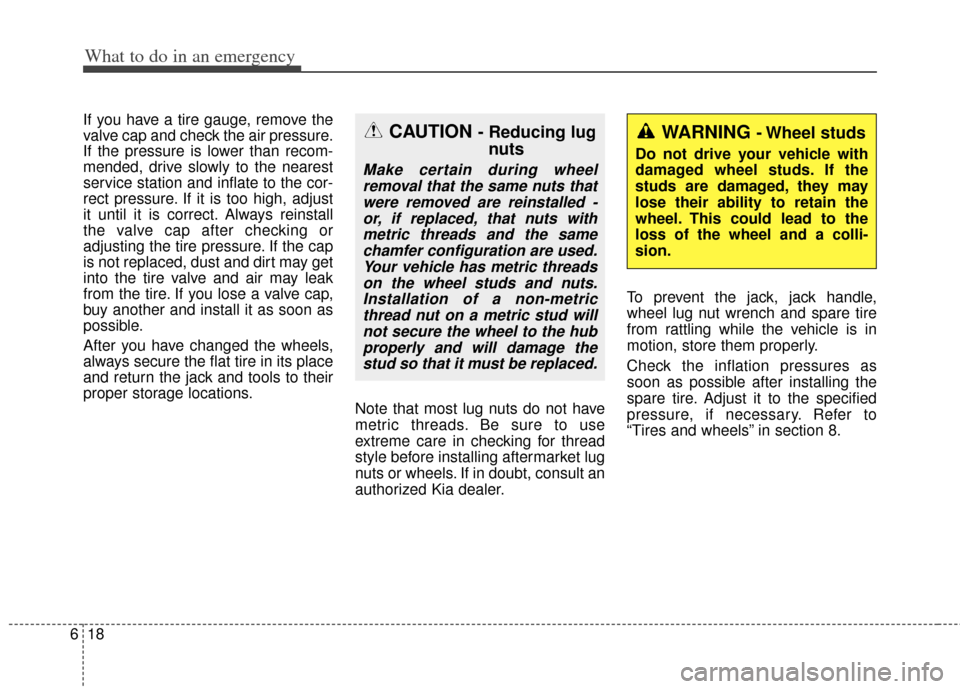2012 KIA Soul spare wheel
[x] Cancel search: spare wheelPage 11 of 393

Index
8I
Seating capacity ··················\
··················\
··················\
·······5-52
Seats ··················\
··················\
··················\
··················\
·········3-2Armrest(front) ··················\
··················\
··················\
·······3-9
Folding the rear seat ··················\
··················\
··············3-10
Front seat adjustment ··················\
··················\
··············3-4
Headrest(front) ··················\
··················\
··················\
······3-6
Headrest(rear) ··················\
··················\
··················\
······3-12
Rear seat ··················\
··················\
··················\
··············3-10
Seat warmer··················\
··················\
··················\
···········3-8
Seatback pocket··················\
··················\
··················\
·····3-9
Shopping bag holder ··················\
··················\
················4-103
Side impact air bag ··················\
··················\
··················\
··3-47
Smart key ··················\
··················\
··················\
··················\
·4-9
Smooth cornering··················\
··················\
··················\
·····5-46
Snow tires ··················\
··················\
··················\
················5-49
Spare tire Compact spare tire ··················\
··················\
················6-19
Compact spare tire replacement ··················\
··············7-45
Removing and storing the spare tire ··················\
·······6-14
Special driving conditions ··················\
··················\
·········5-44 Driving at night ··················\
··················\
··················\
···5-46
Driving in flooded areas··················\
··················\
········5-47
Driving in the rain ··················\
··················\
·················5-47\
Hazardous driving conditions ··················\
·················5-44\
Highway driving··················\
··················\
··················\
··5-48
Rocking the vehicle··················\
··················\
···············5-45
Smooth cornering ··················\
··················\
··················\
5-46
Speedometer··················\
··················\
··················\
·············4-41
Sports mode ··················\
··················\
··················\
·············5-22 SRS components and functions ··················\
··················\
·3-36
Starting difficulties, see engine will not start ··················\
6-4
Steering wheel···············\
··················\
··················\
·············4-34
Electric power steering··················\
··················\
··········4-34
Horn··················\
··················\
··················\
··················\
···4-35
Tilt steering ··················\
··················\
··················\
·········4-35
Steering wheel audio control ··················\
··················\
···4-110
Steps For Determining Correct Load Limit ··················\
5-53
Storage compartment ··················\
··················\
·················4-98\
Center console storage ··················\
··················\
··········4-98
Glove box ··················\
··················\
··················\
············4-98
Luggage box ··················\
··················\
··················\
········4-99
Multi box ··················\
··················\
··················\
·············4-99
Sunroof··················\
··················\
··················\
··················\
···4-30
Sunvisor ··················\
··················\
··················\
·················4-10\
1
Tachometer··················\
··················\
··················\
···············4-41
Tailgate··················\
··················\
··················\
··················\
···4-20
Tether anchor system ··················\
··················\
·················3-28\
Tilt steering ··················\
··················\
··················\
··············4-35
Tire and loading information label ··················\
··············5-52
Tire mobility kit ··················\
··················\
··················\
·······6-21
Tire pressure monitoring system (TPMS) ··················\
·····6-8
Tire specification and pressure label ··················\
·············8-8
T
Page 12 of 393

I9
Index
Tires and wheels ··················\
··················\
·················7-41\
, 8-3Checking tire inflation pressure ··················\
··············7-42
Compact spare tire replacement ··················\
··············7-45
Recommended cold tire inflation pressures ··············7-41
Tire care··················\
··················\
··················\
···············7-41
Tire maintenance ··················\
··················\
··················\
·7-46
Tire replacement ··················\
··················\
··················\
··7-45
Tire rotation ··················\
··················\
··················\
·········7-43
Tire sidewall labeling ··················\
··················\
············7-46
Tire traction ··················\
··················\
··················\
·········7-46
Wheel alignment and tire balance ··················\
···········7-44
Wheel replacement ··················\
··················\
················7-46
Towing ··················\
··················\
··················\
··················\
···6-27
Towing capacity ··················\
··················\
··················\
·······5-53
Transaxle Automatic transaxle ··················\
··················\
··············5-20
Manual transaxle ··················\
··················\
··················\
·5-17
Trip computer ··················\
··················\
··················\
··········4-44 Vehicle break-in process ··················\
··················\
··············1-5
Vehicle capacity weight ··················\
··················\
·············5-52
Vehicle certification label ··················\
··················\
············8-7
Vehicle curb weight ··················\
··················\
··················\
·5-57
Vehicle handling instruncions··················\
··················\
······1-5
Vehicle identification number (VIN) ··················\
·············8-7
Vehicle load limit ··················\
··················\
··················\
·····5-52
Cargo capacity ··················\
··················\
··················\
·····5-53
Certification label ··················\
··················\
··················\
5-55
Seating capacity ··················\
··················\
··················\
··5-52
Steps For Determining Correct Load Limit ··············5-53
Tire and loading information label··················\
··········5-52
Towing capacity ··················\
··················\
··················\
··5-53
Vehicle capacity weight ··················\
··················\
········5-52
Vehicle stability management ··················\
··················\
····5-34
Vehicle weight ··················\
··················\
··················\
·········5-57 Base curb weight ··················\
··················\
··················\
·5-57
Cargo weight ··················\
··················\
··················\
·······5-57
GAW (Gross axle weight) ··················\
··················\
·····5-57
GAWR (Gross axle weight rating)··················\
··········5-57
GVW (Gross vehicle weight)··················\
··················\
5-57
GVWR (Gross vehicle weight rating) ··················\
····5-57
Vehicle curb weight··················\
··················\
···············5-57
Volume/weight ··················\
··················\
··················\
···········8-3V
Page 287 of 393

What to do in an emergency
86
TIRE PRESSURE MONITORING SYSTEM (TPMS) (IF EQUIPPED)
Low tire pressure telltale /
TPMS malfunction indicator
Each tire, including the spare (if pro-
vided), should be checked monthly
when cold and inflated to the inflation
pressure recommended by the vehi-
cle manufacturer on the vehicle plac-
ard or tire inflation pressure label. (If
your vehicle has tires of a different
size than the size indicated on the
vehicle placard or tire inflation pres-
sure label, you should determine the
proper tire inflation pressure for
those tires.)As an added safety feature, your
vehicle has been equipped with a tire
pressure monitoring system (TPMS)
that illuminates a low tire pressure
telltale when one or more of your
tires is significantly under-inflated.
Accordingly, when the low tire pres-
sure telltale illuminates, you should
stop and check your tires as soon as
possible, and inflate them to the
proper pressure. Driving on a signifi-
cantly under-inflated tire causes the
tire to overheat and can lead to tire
failure. Under-inflation also reduces
fuel efficiency and tire tread life, and
may affect the vehicle’s handling and
stopping ability.
Please note that the TPMS is not a
substitute for proper tire mainte-
nance, and it is the driver’s responsi-
bility to maintain correct tire pres-
sure, even if under-inflation has not
reached the level to trigger illumina-
tion of the TPMS low tire pressure
telltale.
Your vehicle has also been equipped
with a TPMS malfunction indicator to
indicate when the system is not
operating properly. The TPMS mal-
function indicator is combined with
the low tire pressure telltale. When
the system detects a malfunction,
the telltale will flash for approximate-
ly one minute and then remain con-
tinuously illuminated. This sequence
will continue upon subsequent vehi-
cle start-ups as long as the malfunc-
tion exists. When the malfunction
indicator is illuminated, the system
may not be able to detect or signal
low tire pressure as intended. TPMS
malfunctions may occur for a variety
of reasons, including the installation
of replacement or alternate tires or
wheels on the vehicle that prevent
the TPMS from functioning properly.
Always check the TPMS malfunction
telltale after replacing one or more
tires or wheels on your vehicle to
ensure that the replacement or alter-
nate tires and wheels allow the
TPMS to continue to function proper-
ly.
Page 290 of 393

611
What to do in an emergency
Changing a tire with TPMS
If you have a flat tire, the Low Tire
Pressure telltale will come on. Have
the flat tire repaired by an authorized
Kia dealer as soon as possible or
replace the flat tire with the spare
tire.
Each wheel is equipped with a tire
pressure sensor mounted inside the
tire behind the valve stem. You must
use TPMS specific wheels. It is rec-
ommended that you always have
your tires serviced by an authorized
Kia dealer.Even if you replace the low pressure
tire with the spare tire, the Low Tire
Pressure telltale will remain on until
the low pressure tire is repaired and
placed on the vehicle.
After you replace the low pressure
tire with the new tire with TPMS, the
TPMS malfunction indicator may illu-
minate after a few minutes because
the TPMS sensor mounted on the
spare wheel is not initiated.
Once the low pressure tire is reinflat-
ed to the recommended pressure
and installed on the vehicle or the
TPMS sensor mounted on the
replaced spare wheel is initiated by
an authorized Kia dealer, the TPMS
malfunction indicator and the low tire
pressure telltale will extinguish within
a few minutes of driving.
If the indicator is not extinguished
after a few minutes of driving, please
visit an authorized Kia dealer.
If a original mounted tire is replaced
with the spare tire, the TPMS sensor
on the replaced spare wheel should
be initiated and the TPMS sensor on
the original mounted wheel should
be deactivated. If the TPMS sensor
on the original mounted wheel locat-
ed in the spare tire carrier still acti-
vates, the tire pressure monitoring
system may not operate properly.
Have the tire with TPMS serviced or
replaced by an authorized Kia deal-
er.
CAUTION
Never use a puncture-repairing
agent not approved by Kia torepair and/or inflate a low pres-sure tire. The tire sealant notapproved by Kia may damagethe tire pressure sensor. Thesealant on the tire pressure sen-sor and wheel shall be eliminat-ed when you replace the tirewith a new one.
Page 292 of 393

613
What to do in an emergency
IF YOU HAVE A FLAT TIRE (WITH SPARE TIRE, IF EQUIPPED)
Jack and tools
The jack, jack handle, wheel lug nut
wrench are stored in the luggage
compartment. Pull up the luggage
box cover to reach this equipment.
(1) Jack handle
(2) Jack
(3) Wheel lug nut wrench
Jacking instructions
The jack is provided for emergency
tire changing only.
To prevent the jack from “rattling”
while the vehicle is in motion, store it
properly.
Follow jacking instructions to reduce
the possibility of personal injury. Always move the vehicle complete-
ly off the road and onto the shoul-
der before trying to change a tire.
The jack should be used on a firm
level ground. If you cannot find a
firm, level place off the road, call a
towing service company for assis-
tance.
Be sure to use the correct front and rear jacking positions on the vehi-
cle; never use the bumpers or any
other part of the vehicle for jacking
support.
OAM069002WARNING - Changingtires
Never attempt vehicle repairs in
the traffic lanes of a public road
or highway.
WARNING - Jack
Do not place any portion of your
body under a vehicle that is
only supported by a jack since
the vehicle can easily roll off the
jack. Use vehicle support
stands.
Page 294 of 393

615
What to do in an emergency
4. Remove the wheel lug nut wrench,jack, jack handle, and spare tire
from the vehicle.
5. Block both the front and rear of the wheel that is diagonally opposite
from the jack position. To prevent vehicle movement while
changing a tire, always set the
parking brake fully, and always
block the wheel diagonally oppo-
site the wheel being changed.
We recommend that the wheels of the vehicle be blocked, and that no
person remain in a vehicle that is
being jacked.
6. Loosen the wheel lug nuts coun-terclockwise one turn each, but do
not remove any nut until the tire
has been raised off the ground.
1VQA4023OAM069001
Page 295 of 393

What to do in an emergency
16
6
7. Place the jack at the front or rear
jacking position closest to the tire
you are changing. Place the jack
at the designated locations under
the frame. 8. Insert the jack handle into the jack
and turn it clockwise, raising the
vehicle until the tire just clears the
ground. This measurement is
approximately 30 mm (1 in.).
Before removing the wheel lug
nuts, make sure the vehicle is sta-
ble and that there is no chance for
movement or slippage. 9. Loosen the wheel nuts and
remove them with your fingers.
Slide the wheel off the studs and
lay it flat so it cannot roll away. To
put the wheel on the hub, pick up
the spare tire, line up the holes
with the studs and slide the wheel
onto them. If this is difficult, tip the
wheel slightly and get the top hole
in the wheel lined up with the top
stud. Then jiggle the wheel back
and forth until the wheel can slide
over the other studs.
OCM054013OAM069009
Page 297 of 393

What to do in an emergency
18
6
If you have a tire gauge, remove the
valve cap and check the air pressure.
If the pressure is lower than recom-
mended, drive slowly to the nearest
service station and inflate to the cor-
rect pressure. If it is too high, adjust
it until it is correct. Always reinstall
the valve cap after checking or
adjusting the tire pressure. If the cap
is not replaced, dust and dirt may get
into the tire valve and air may leak
from the tire. If you lose a valve cap,
buy another and install it as soon as
possible.
After you have changed the wheels,
always secure the flat tire in its place
and return the jack and tools to their
proper storage locations.
Note that most lug nuts do not have
metric threads. Be sure to use
extreme care in checking for thread
style before installing aftermarket lug
nuts or wheels. If in doubt, consult an
authorized Kia dealer.To prevent the jack, jack handle,
wheel lug nut wrench and spare tire
from rattling while the vehicle is in
motion, store them properly.
Check the inflation pressures as
soon as possible after installing the
spare tire. Adjust it to the specified
pressure, if necessary. Refer to
“Tires and wheels” in section 8.WARNING - Wheel studs
Do not drive your vehicle with
damaged wheel studs. If the
studs are damaged, they may
lose their ability to retain the
wheel. This could lead to the
loss of the wheel and a colli-
sion.
CAUTION - Reducing lug
nuts
Make certain during wheel
removal that the same nuts thatwere removed are reinstalled -or, if replaced, that nuts withmetric threads and the samechamfer configuration are used.Your vehicle has metric threadson the wheel studs and nuts.Installation of a non-metricthread nut on a metric stud willnot secure the wheel to the hubproperly and will damage thestud so that it must be replaced.